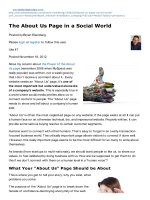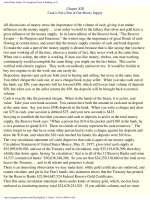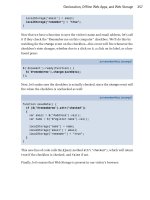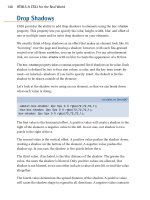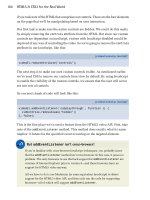wiley philanthropy in a flat world phần 6 doc
Bạn đang xem bản rút gọn của tài liệu. Xem và tải ngay bản đầy đủ của tài liệu tại đây (91.88 KB, 23 trang )
The Global Philanthropy Crisis
99
global North. Now both the money and the development
needs are increasingly to be found everywhere.
The international fundraiser, Ken Burnett tells
the story of a session that Bernard Ross, (founder of the
Management Centre, a non - profi t consultancy based
in the UK) once ran, where a woman from a charity
in Ethiopia fi rst encountered direct marketing. She
returned to Addis Ababa, the country ’ s capital, to try it
out, and received a nearly 40 percent response rate.
What is this telling us? It is fi rst telling us that peo-
ple in countries that have been traditionally nonfundrais-
ing countries are starting to move into fundraising. The
Ukraine has just organized its seventh fundraising con-
gress. Poland has just created a national fundraising associ-
ation. Georgia just ran its fi rst - ever fundraising conference.
Hungary is creating a fundraising training certifi cate so
that the profession can be recognized! Training and devel-
opment in fundraising are happening across the globe,
as the fl at world increases the need and the opportunity
to do incredible work funded locally. I have been lucky
enough to be involved in some of these programs over the
past few years, and have been blown away by the creativity
FLAT AND BEAUTIFUL
100
and the drive of our new fundraising colleagues, many
of whom had never heard of fundraising until very
recently. These new kids on the block are the ones who
are redefi ning our profession. They don ’ t know the
rules of fundraising, and there is nothing more pow-
erful than someone who is determined and passionate,
and doesn ’ t know the rules.
The rules are there as a normative device for us,
because most nonprofi t organizations are naturally con-
servative, with boards who don ’ t like taking risks. We
know that if we follow X or Y fundraising technique,
with a certain type of message addressed in a certain way
to a certain type of audience, we will get Z result. QED.
The problem is that new and excited fundraisers
don ’ t know these norms, and they follow the best norm
of all — passionate common sense. This is, in my view, the
most powerful skill that any fundraiser can have, the most
powerful tool in any philanthropic box. We must learn
from them. The fl at philanthropic world requires it.
We cannot talk about global philanthropy without
talking about diaspora fundraising. It is one of the largest
sources of untapped revenue for many nonprofi t organi-
zations (NPOs) around the world. We only have to look
The Global Philanthropy Crisis
101
at the billions that are transferred through Western Union
each year from emigrants who are making money in
more developed economies and who are sending back
money to keep their families alive.
What is interesting about diaspora is that it is
starting to go back the other way, with fl ows of funds
from rich Indian families to depressed Indian com-
munities in the United Kingdom as an example. It is
the same for Mexican funds into the United States.
Again, the concept of the need being in India and the
funds being in the UK, or the need being in Mexico
and the funds being in the United States, is increas-
ingly outdated. The fl at philanthropic world has put
an end to this.
How can we react to, and grow with, the oppor-
tunities presented by the fl at philanthropic world?
Are there tools and keys that we need to master to be
effective as fundraisers in the world of tomorrow?
The answer to this question is a most resounding
yes. There are things that we all need to integrate, con-
cepts that we need to work with, and refl exes that we
need to develop. We are going to explore these in the
second part of this book, but before doing this there is
FLAT AND BEAUTIFUL
102
one fundamental question that needs to be asked on
the relationship between nonprofi ts and development.
The World Bank publishes fi gures on the estimated
number of people in various countries and regions liv-
ing on less than $ 1 per day. Let ’ s compare these fi gures
for China, South Asia (including India), and sub - Saharan
Africa, three completely different regions being affected
by globalization in very different ways.
China
1990: 375 million Chinese living on < $ 1 per day
2001: 212 million
2015: on the basis of current trends 16 million
South Asia: India, Pakistan, and Bangladesh
1990: 462 million
2001: 431 million
2015: on the basis of current trends 216 million
Sub - Saharan Africa
1990: 227 million
2001: 313 million
2015: on the basis of current trends 340 million
Why?
The Global Philanthropy Crisis
103
What explains this? Can we pin down a number
of factors? Can we try to isolate what is keeping Africa
from its potential? This book, or this author, does not
have the pretension to believe that it can offer any solu-
tions to global development issues that are being worked
on and tested by hundreds of thousands of professionals
around the world. However, I do believe that we can
gain a deeper understanding of the African situation by
learning from some of Thomas Friedman ’ s work.
Development and Flatness
In The World Is Flat, Friedman argues that there are
three keys to succeeding as a country in a fl at world.
First, you need the infrastructure to connect people
to the fl at world: Internet, phones, roads, airports, and
so on.
Second, you need education to get people innovat-
ing and collaborating.
Third, you need strong governance both on a local
and on a national level to ensure that individuals have a
stable playing fi eld from which to innovate and develop.
FLAT AND BEAUTIFUL
104
This list may or may not be exhaustive, but it does
have the advantage of giving us a guide to look at our
activities as nonprofi ts. And when we do this, there are a
couple of striking things. Let ’ s start with infrastructure.
International development nongovernmental orga-
nizations (NGOs) do a huge amount of work in pro-
viding basic infrastructure, such as wells, access to
drinking water, and in some cases telecommunications.
But when I asked one of my students at St. Mary ’ s
University (Minnesota) Philanthropy and Development
program—an incredible gentleman named Benyam
Addis from Ethiopia, what his country most needed,
his answer was unequivocal: roads. Are international
nonprofi ts spending donor dollars building roads? I did
some research on a dozen or so major international
organizations and couldn ’ t fi nd much, if any informa-
tion on the subject. Does that mean we are not build-
ing roads, when people clearly think it would be the
best investment? And I imagine that not very many
nonprofi ts are involved in creating airports . . . .
What about education? This is something that
hundreds of development nonprofi ts are covering at a
grassroots level, all across the world. But if we look at
The Global Philanthropy Crisis
105
the countries that are pulling themselves out of poverty,
such as India and China, where are they investing their
education budgets? Not in grassroots schooling, but in
universities. There is a key question here: is it in a pop-
ulation ’ s best interests to have everybody educated to
the age of 7, or to have a small number of people edu-
cated to MBA level? Should we be concentrating our
work on making macro rather than micro educational
decisions? Is it in the best interests of a society to aban-
don some children to illiteracy? And if so, who has the
right to make such a decision? Is it our responsibility as
citizens of the fl at world? Is it the individual ’ s responsi-
bility? Is it the government ’ s responsibility?
And what about governance? Most development
nonprofi ts have some kind of Global South lobby-
ing programs, but why are we not seeing more NGOs
attacking the root causes of ineffective governance in
places like Africa or South Asia? Why do we not hear
more about this? Is it not sexy? Aside from a hand-
ful of organizations such as Amnesty International,
Transparency, and Oxfam, which lobby hard and push
governance as a key mission issue, as donors, we hear
very little about this. Yet one thing is certain: the area
FLAT AND BEAUTIFUL
106
that is likely to have the most positive impact in terms
of population, wealth creation, and development in
Africa is governance. We need strong, effective govern-
ance nonprofi ts making a difference, picking away at
regimes on the ground, naming and shaming and forcing
governments to modify their corrupt and ineffective local
governance structures. Free the people from the burden
of poor governance, and people will free themselves for
the rest. Think Microcredit; think Muhammad Yunus.
What Yunus shows is that people can free them-
selves from poverty if we stop stopping them — if we
help to remove the barriers that keep them in poverty.
This works not just in Asia and Africa but in devel-
oped countries, too. Microcredit is on the rise in North
America and Europe as a way of helping poor, under-
privileged members of depressed communities to work
their own way to a better life.
There are no easy answers to the questions we are
raising here. In fact, for many of the questions there may
be no answers at all. Our hope is that we are putting the
questions in a new way, one that will cause us to think
and to reassess the impacts of globalization on our lives,
on our organizations, and on the decisions that we all
The Global Philanthropy Crisis
107
make as individuals. It seems a generalization to say that
everything is changing; however, that statement is prob-
ably much closer to the reality than we think. The fl at
world and the fl at philanthropic world are concepts that
we are going to have to deal with. They bring to the fore
questions that are very uncomfortable. That challenge us.
That challenge our values, our preconceptions, our exist-
ing ways of doing things, our habits, our ideas, and our
world. That challenge our relationships to those around
us, both in our local and in our global communities.
I believe very strongly that we need to do three
things in response to these questions:
1. Not be afraid to ask them.
2. Not be afraid of the answers, however scary, uncom-
fortable, and anxiety - generating they may be.
3. Keep true to our values and be the change we want
to see in the world.
Part Two
SURVIVING AND THRIVING
111
Chapter Four
From Fifties to Fractions
Whether we like it or not, we are all citizens of a
world dominated by markets. We are surrounded by
the mania of markets and live in a society where
money is meaning and where freedom does not
always equal happiness.
— Karaoke Capitalism
Surviving in the globalized world is fi rst a question
about recognizing what a globalized world is. In the
fi rst part of this book, we spent time looking at how
the globalized world has developed, and what the
SURVIVING AND THRIVING
112
implications and the realities of this brave new world
are. Now let ’ s address some of the ways that we can use
these questions and the fl at philanthropic world to help
grow our organizations.
In the good old days, when a spade was a spade
and not a garden improvement facilitator, things were
much simpler. Charities had missions, they had ben-
efi ciaries, and they had donors. Mostly, the benefi ciar-
ies had a need of some sort that they couldn ’ t pay for
or weren ’ t aware of, the donors had money and good-
will, and the charities had the capacity to transform
the donors ’ money into services or activities that met
those benefi ciaries ’ needs. This is what I call “ Fifties
Fundraising, ” as it reminds me of when life was sim-
ple, when products did what they said on the boxes,
and when everyone knew their role and got on with
it, kind of like in the 1950s.
Then the world pancaked.
Nowadays, charities still have missions, benefi ciaries
(at least for the most part), and donors (again, for the
most part). But that is where the similarities end. Today,
benefi ciaries may be donors, while donors may be ben-
efi ciaries; organizations may be providing government
From Fifties to Fractions
113
services, while governments may be inciting donors to
give through tax breaks; benefi ciaries may be totally
heterogenic, from different groups, societies, and cultures
with differing needs; likewise for donors, who may have
totally different motivations according to the need they
want to fund your organization to meet; organizations
may collaborate and each meet only part of the need;
and added to all that, now benefi ciaries and donors can
be anywhere on the planet.
We have moved from “ Fifties Fundraising ” to
“ Fraction Fundraising, ” where every action, intent, or
project has to encompass an ever - increasing number
of needs, expectations, challenges, and hopes. Fraction
Fundraising is about just that — about having the skills,
the talent, the tools, and the knowledge to fraction
out each objective in order to ensure that it is not just
meeting, but optimizing the needs of every stakeholder
involved. And, as we have already seen, those needs and
expectations are getting higher and higher as the world
gets fl atter and fl atter.
Fraction Fundraising is also about looking to new
places and recognizing that the fl at world platform
allows fractioning on a global level. Today, our donors
SURVIVING AND THRIVING
114
and our benefi ciaries can literally be anywhere on the
planet. And so can we. And that is the challenge of frac-
tioning. How can I, as a fundraiser, possibly run such a
complex equation of needs and expectations when the
individuals behind them could be anywhere in the world?
In November 2001, just a few days after 9/11, a
terrible explosion ripped through the city of Toulouse,
in southwest France. Windows blew out on houses for
miles around the epicenter of the explosion. The blast
could be heard more than 70 miles away. The people
of Toulouse had no idea what had hit them. It was
not terrorists, but the AZF Chemical plant located in
the middle of the city exploding after a chemical leak.
Six years later, in early summer 2007, after a mam-
moth cleaning - up operation, the foundation stone was
laid for a brand - new cancer research and treatment
center — the Canceropole Toulouse, to be built on the
site of the old chemical plant.
The cancer center, brainchild of Philippe Douste -
Blazy, the former mayor of the city, is being created with
a pot of public money, some leading - edge public - private
partnerships, and a huge international fundraising drive.
The Fondation InNaBioSante has been created to
From Fifties to Fractions
115
coordinate and pilot the fundraising efforts, and I have
had the pleasure of working with them to do it. But
the interesting thing about this Foundation is that it
could not have existed 10 years ago. It simply would
not have had a mandate, or been able to put the same
vision together. So what is this vision? It is a global
vision, made possible by local capacity. The vision is
a world without cancer, so there ’ s nothing new there.
But the Foundation believes that the unique infrastruc-
ture of the Canceropole Toulouse stands a real chance
of bringing them one giant leap closer. Why? Because
the center brings together a hospital, research facilities,
and clinics, which means that the scientists working in
their labs are going to be just a few doors down from
the patients in their beds. This closeness should serve
both, helping scientists get closer to the real illness and
giving patients access to revolutionary new treatment
trials. And it also brings together scientists and doctors
from around the world, who will be offered short - term
research tenures in the state - of - the - art facilities.
So, this is a global project — curing cancer — that
is attracting interest from serious funders around the
world, from the United States, the Middle East, Asia,
SURVIVING AND THRIVING
116
and elsewhere. But it is made possible only through the
infrastructure provided in one particular area of France
thanks to a chemical plant that blew up.
A local response, turned into a global vision, funded
by global money, made possible by local capacity: a
totally fl at philanthropic world concept.
This idea of local closeness and capacity with
international reach is a trend that we have been see-
ing for a number of years. The desire to get closer to
grass roots but at the same time reach for the stars is a
twenty - fi rst - century paradox. And it doesn ’ t look like
it will go away anytime soon. Belonging to a tribe on a
local level is increasingly important. If we feel we don ’ t
belong to a tribe, we feel lost. And tribes are small - scale
operations. But they all have access to the Internet.
Politically, Europe has been following this trend
since the fall of the Berlin Wall. Think Yugoslavia. Think
even of the United Kingdom, where devolution has
given more power to the Scottish, Welsh, and Northern
Irish parliaments and locally elected offi cials than at
any time in recent history. The age - old nation is being
slowly replaced by more local, more regional, and more
From Fifties to Fractions
117
tribal gauges of identity. People increasingly want to
belong somewhere close.
But this brings us to another question.
What if that somewhere close were global? What
if the distinction between local and global actually no
longer existed? What if distance now no longer mat-
tered and everything was global?
One thing is clear — the goalposts are moving. In
fact, to be more precise, the goalposts are moving on
a playing fi eld that is continually tilting in different
directions, and neither phenomenon shows any sign of
stopping. Quite the contrary.
So how do we navigate these troubled waters to
ensure that the reasons our organizations exist continue
to be championed? What do we have to do so that the
support we provide to our benefi ciaries can continue and
increase tomorrow? Where is the road map for the fl at
philanthropic world?
In short, there are no answers. There is no map. The
rulebook hasn ’ t been written. Indeed, even if it had
been written, the rules would have changed so many
times since that it would be completely useless now.
SURVIVING AND THRIVING
118
However, this is not satisfactory. We have to have
a go, and try to put our collective heads together and
come up with something better than that.
Over the past few years, through my work with non-
profi ts and students of philanthropy around the world,
I have asked and discussed these questions with hun-
dreds of people. And, I am thrilled to say, there appears
to be some kind of consensus. It is too early to say if
this consensus will hold. But it exists. And as a result, it
is my privilege to be able to share, in the next few chap-
ters, some of the ideas and strategies of this consensus on
how we can live, thrive, and survive in the fl at philan-
thropic world.
119
Chapter Five
The Four - Step Plan to Flat
Philanthropic Success
Step 1: Rationalize
Nonprofi t organizations are complicated animals. Whereas
companies produce, sell, and manage relationships in an
environment where the principal objective is making
money, we have to produce, sell, and manage relationships
in an environment where the principal objective is not
making money.
This could at fi rst appear to be simpler, but after
analysis we realize that it is much more complex. Why?
SURVIVING AND THRIVING
120
Because a company has a certain sway over its suppliers,
who provide the material wherewithal for them to realize
their product and sell it to their consumers.
As nonprofi ts we are funded by donors who are pay-
ing for a service they are not receiving, which means that
we have very little sway over our suppliers (our donors).
If a company is not happy with the performance of a
supplier, it can change and move to another competitor.
If we are not happy with the performance of our donors,
we cannot simply move to other donors. We are there-
fore much more dependent on our suppliers. This means
that we have to be extra skillful in building relationships,
both with donors and with benefi ciaries.
However, many nonprofi ts are structured not around
building relationships, but around fundraising, com-
munications, programs, and often a myriad of other
activities — topped off with a fairly heavy management/
administration level.
Bruno David is the chair of a small French associa-
tion, Noir et Blanc. The charity works to fi ght sickle - cell
anemia in Africa through a mix of research, lobbying,
and patient care. This very streamlined organization has
few staff members, and much of their activity is focused
The Four - Step Plan to Flat Philanthropic Success
121
on the ground in the Democratic Republic of Congo.
Early in 2007, Bruno and I had a conversation that
was to be one of the most important in my fundrais-
ing career. The starting point was that Bruno wanted
to begin fundraising for his charity to increase income to
meet growing demands for their services in Africa. But it
all got interesting when I mentioned that to raise money
you often needed to invest, at least at the start, and to
build capacity, employ talented staff, and give them the
opportunity to develop. Bruno didn ’ t seem interested in
this. His argument was that Noir et Blanc did two things
better than any other organization on the face of the
planet: they identifi ed promising research projects into
the disease, and they provided hands - on patient care in
diffi cult - to - reach parts of Africa. This was what they did.
And they did it better than anyone else. So, the argu-
ment went, why should the organization take its eye off
the ball and start trying to do something else that was
not what it did best? Surely it would make more sense to
give that over to someone else.
What Noir et Blanc were saying here was not just
unusual; it was positively groundbreaking. They had
understood what they did better than anyone else on
